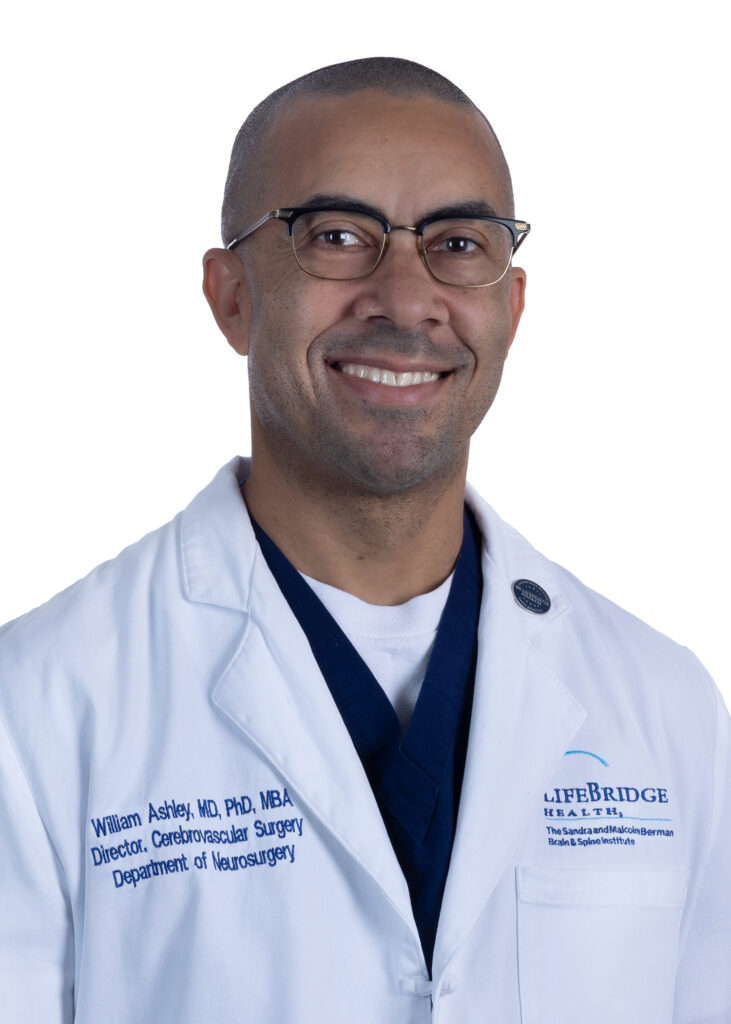February is Black History Month and we want to celebrate the first African American graduate of the Washington University Neurosurgery Residency program, William W. Ashley, Jr., MD, PhD, MBA.

Dr. Ashley was born and raised in Chicago, IL, “I’ve been a lot of places, but haven’t found any place quite like it,” and graduated from Stanford University with a degree in biology. He then earned his medical degree and doctoral degree in physiology and biophysics at the University of Illinois College of Medicine. Additionally, Dr. Ashley completed an MBA in healthcare administration from Loyola University in Chicago before completing his neurosurgical residence in 2007.
Today, Dr. Ashley serves as the Director of the Cerebrovascular, Endovascular & Skull Base Neurosurgery and Chief of the Division of Neurointerventional Radiology at the Sinai Hospital of Baltimore in Maryland. He is also the President of the American Society of Black Neurosurgeons and a passionate advocate for increasing Black and under-represented minorities in the field of neurosurgery.
What drew you to studying neurosurgery at Washington University?
Washington University offered a dynamic combination of clinical and research excellence. The program also had a great track record. At the end of the day, it offered what I felt to be the best neurosurgical training available at the time. I was prepared to travel to whatever part of the country it took to obtain the best neurosurgical training, but it was also nice that St. Louis wasn’t too far from home. Oh – and did I mention the toasted ravioli?
What is your most memorable moment training at WashU?
As you may imagine, there were many moments that left a lasting impression on me. One of the experiences I always seem to talk about was the great time I had while on the Ireland Rotation. That was a once in a lifetime experience. Slainte!

If you could go back in time and talk to your younger self during residency training, what advice would you impart?
Balance is important. Work hard but also take time to foster/develop important personal interests.
You are the first African American graduate of the Washington University neurosurgery department. How does that distinction make you feel?
Bittersweet. Apart from race, it was certainly an honor and privilege to train at WashU. I think that sentiment would be the same for a trainee of any race. I am pleased that WashU saw the value in training residents of diverse racial backgrounds. But it is disheartening when I really think about the fact that in 2007, I was the first Black to graduate from such an esteemed program. I was encouraged to see Dr. Bradley Stephens coming after me, graduating in 2017.
Though there are many qualified Black medical students interested in becoming a neurosurgeon, 64 (55%) of neurosurgical programs don’t have a single Black resident across all years. Indeed, 52/116 programs account for all the Black residents in neurosurgery across all years (ACGME, 2021). Thus, as a specialty we have a long way to go. But at least now we are having the conversation and beginning the process of meaningful change. WashU is taking this seriously and I was so pleased to see my friend and colleague, Dr. Brenton Pennicooke, join the faculty there. He is a real asset and has joined a great team.
Currently, you serve as the President of the American Society of Black Neurosurgeons, Inc. How can neurosurgery departments do a better job at increasing under-represented minorities in academia?
Big question – how much time do I have? First step is recognition that there is a problem and that all of us play a role in the solution. There must be a formal effort to gather program- specific data about diversity. Each program should set meaningful, realistic, and measurable short and long-term goals for diversity. This includes goals for training diverse residents and hiring and supporting diverse faculty in tenure-track positions.
To do this, Black and underrepresented minorities must be prioritized in the match process and hiring process. There must be careful reflection on the program as to why it has been unsuccessful in recruitment and retention and a commitment to change – even if it’s difficult or unpopular. Look to programs with excellent diversity track records as a model of best practice. Be committed to diversity and not the appearance of diversity. This requires empowering DEI committees with ability to make real change. Overall, programs must take a lesson from evolution and internalize the value of diversity in the survival of our specialty and in our ability to provide excellent care to all our diverse patients.